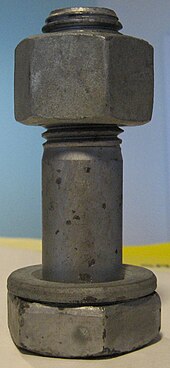Fastener
This article needs additional citations for verification. (February 2009) |

A fastener is a hardware device that mechanically joins or affixes two or more objects together.
Fasteners can also be used to close a container such as a bag, a box, or an envelope; or they may involve keeping together the sides of an opening of flexible material, attaching a lid to a container, etc. There are also special-purpose closing devices, e.g. a bread clip. Fasteners used in these manners are often temporary, in that they may be fastened and unfastened repeatedly.
Some types of woodworking joints make use of separate internal reinforcements, such as dowels or biscuits, which in a sense can be considered fasteners within the scope of the joint system, although on their own they are not general purpose fasteners.
Furniture supplied in flat-pack form often uses cam dowels locked by cam locks, also known as conformat fasteners.
Items like a rope, string, wire (e.g. metal wire, possibly coated with plastic, or multiple parallel wires kept together by a plastic strip coating), cable, chain, or plastic wrap may be used to mechanically join objects; but are not generally categorized as fasteners because they have additional common uses. Likewise, hinges and springs may join objects together, but are ordinarily not considered fasteners because their primary purpose is to allow articulation rather than rigid affixment.
Other alternative methods of joining materials include: crimping, welding, soldering, brazing, taping, gluing, cementing, or the use of other adhesives. The use of force may also be used, such as with magnets, vacuum (like suction cups), or even friction.
There are three major steel fasteners used in industries: stainless steel, carbon steel, and alloy steel. The major grade used in stainless steel fasteners: 200 series, 300 series, and 400 series.
Industry
In 2005, it is estimated that the United States fastener industry runs 350 manufacturing plants and employs 40,000 workers. The industry is strongly tied to the production of automobiles, aircraft, appliances, agricultural machinery, commercial construction, and infrastructure. More than 200 billion fasteners are used per year in the U.S., 26 billion of these by the automotive industry. The largest distributor of fasteners in North America is the Fastenal Company.[1]
Types

- anchor bolt
- batten
- bolt (fastener)
- brass fastener
- buckle
- button
- cable tie
- captive fastener
- clamp (or cramp)
- clasps
- cleko
- clips
- clutch
- drawing pin (thumbtack)
- flange
- frog
- grommet
- hook-and-eye closure
- hook and loop fastener
- latch
- nail
- pegs
- PEM nut
- pins
- retaining rings
- circlip
- e-ring
- rivet
- rock bolt
- rubber band (or bands of other materials)
- screw anchor
- snap fastener
- staple
- stitches
- strap
- threaded fastener
- tie
- toggle bolt
- treasury tag
- twist tie
- wedge anchor
- zipper
See also
References
- ^ The North American fastener industry - The industry today, archived from the original on 2008-06-13, retrieved 2009-02-08.
Further reading
- Parmley, Robert (1996). Standard Handbook of Fastening and Joining (3 ed.). McGraw Hill. ISBN 9780070485891.
External links
